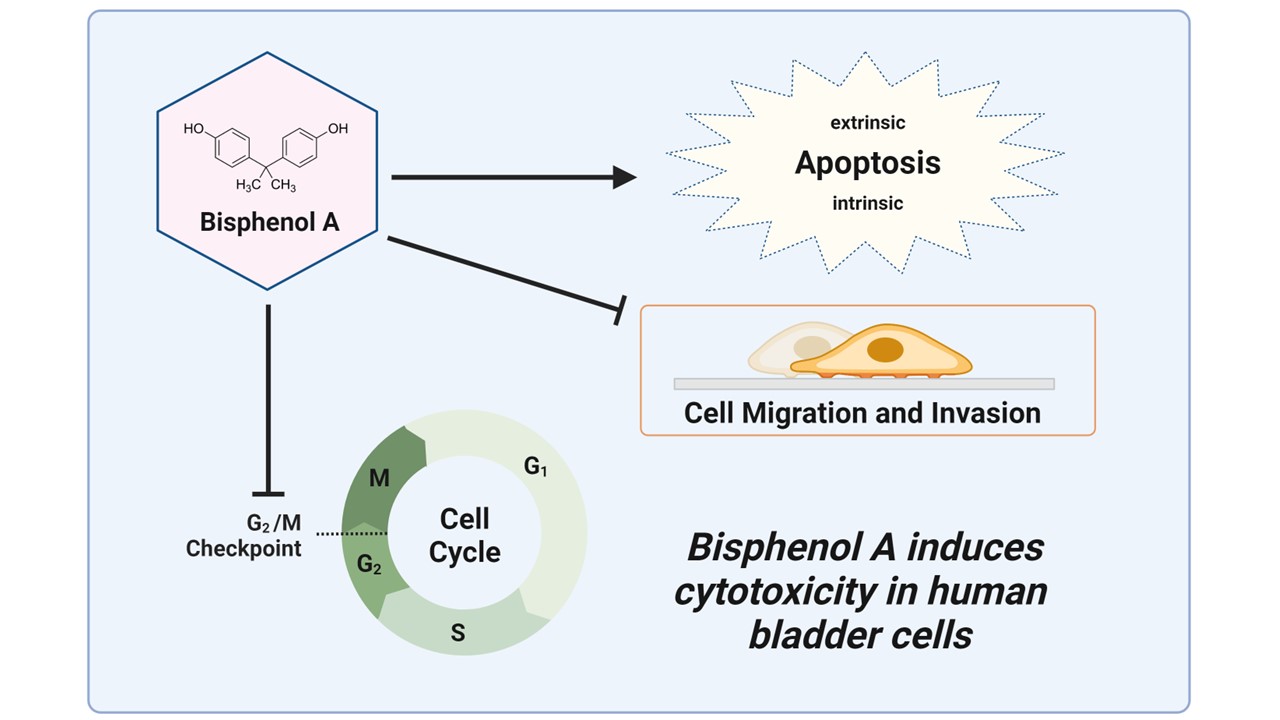News
Jun 5, 2024
- Research
- International
Associate Professor Dong-Ho KIM's Research Group: Elucidating the Underlying Molecular Mechanism by which Bisphenol A Induces Cytotoxicity in Human Bladder Cells
International Collaborative Research
This study was published in "J Biochem Molecular Toxicology" as the result of an international collaboration between "School of Human Life and Ecology, Osaka Metropolitan University", "Department of Food and Nutrition, Chung-Ang University", "College of Oriental Medicine, Dongeui University", and "Department of Urology, Chungbuk National University".
Research Summary
This study provides significant insights into how Bisphenol A (BPA) exerts its detrimental effects on human bladder cells, specifically BdFC and T24 cells. Here is a summary of the key findings and the molecular mechanisms involved:

Apoptosis*1 Induction:
Extrinsic Pathway: BPA activates ATM-CHK1 signaling, which is part of the DNA damage response pathway.
Intrinsic Pathway: BPA induces apoptosis through the CHK2-CDC25c-CDC2 signaling pathway, which also responds to DNA damage and is crucial for cell cycle regulation.
Cell Cycle*2 Arrest:
BPA causes G2/M phase arrest in human bladder cells. This prevents cells from proceeding from the G2 phase to mitosis, thereby inhibiting cell proliferation.
Inhibition of Cell Migration and Invasion*3:
BPA reduces the binding activity of the transcription factors AP-1 and NF-κB, which are important for the expression of genes involved in cell migration and invasion. It also inactivates matrix metalloproteinases MMP2 and MMP9, enzymes that degrade the extracellular matrix and are crucial for cancer cell metastasis.
MAPK Pathway:
BPA's effects on human bladder cells involve the phosphorylation of Mitogen-Activated Protein Kinases (MAPKs). These kinases are part of signaling pathways that regulate various cellular activities, including proliferation, differentiation, and stress responses.
Implications of the Study:
- Endocrine Dysfunction: The study supports the hypothesis that BPA, as an endocrine-disrupting chemical, can cause endocrine dysfunction in the bladder.
- Cytotoxicity: The detailed elucidation of the pathways involved in BPA-induced cytotoxicity can help in understanding the broader implications of BPA exposure on human health, particularly related to bladder diseases.
- Therapeutic Targets: Identifying these pathways provides potential therapeutic targets for mitigating the harmful effects of BPA on human bladder cells.
Conclusion:
The findings of this study enhance our understanding of the molecular mechanisms by which BPA induces toxicity in human bladder cells. By delineating the pathways of apoptosis, cell cycle arrest, inhibition of migration and invasion, and MAPK signaling involvement, this research offers a comprehensive view of how BPA may contribute to bladder endocrine dysfunction and cytotoxicity. These insights are crucial for developing strategies to counteract the negative health effects associated with BPA exposure.
Publication Information
- Journal; J Biochem Molecular Toxicology
- Title; Bisphenol A regulates bladder cells responses via control of G2/M-phase cell cycle, apoptotic signaling, MAPK pathway, and transcription factor-associated MMP modulation
- Authors; Jun-Hui Song1, Byungdoo Hwang1, Solbi Park1, Soobin Kim1, Dong-Ho Kim2, Yung Hyun Choi3, Wun-Jae Kim4, Sung-Kwon Moon1
- Affiliations;
¹Department of Food and Nutrition, Chung-Ang University, Anseong, Republic of Korea
2Department of Nutrition, School of Human Life and Ecology, Osaka Metropolitan University, Osaka, Japan
3Department of Biochemistry, College of Oriental Medicine, Dongeui University, Busan, Republic of Korea
4Department of Urology, Chungbuk National University, Cheongju, Chungbuk, Republic of Korea
- URL of Published; https://onlinelibrary.wiley.com/doi/10.1002/jbt.23662
Terms
*1 Apoptosis: A type of cell death that occurs in multicellular organisms and is actively induced to maintain the individual in a better state is called programmed cell death. This process is induced through various physical, chemical, and biological factors, and the cellular response in apoptosis is tightly regulated. Apoptosis can be broadly classified into extrinsic apoptosis, induced by external stimuli, and intrinsic apoptosis, induced by mitochondria-associated proteins.
*2 Cell cycle: When cells increase in number, cell division occurs. The cell that divides (mother cell) gives rise to new daughter cells, and one of these daughter cells can become a mother cell again to continue the cycle. Cells proliferate through the G1, S, G2, and M phases. The G1 phase, also called the preparatory phase for DNA synthesis, uses the G1 checkpoint and other mechanisms to determine whether to proceed with cell division. DNA replication occurs during the S phase, preparation for cell division occurs during the G2 phase, and cell division occurs during the M phase. This sequence of events is called the cell cycle.
*3 Cell migration and invasion: Cell migration is the movement of cells from one place to another in the body. Cell invasion refers to the gathering of cells at the site of inflammation. Lymphocytic invasion is a condition in which lymphocytes enter various organs. This term is also used to describe the spread of cancer cells into surrounding tissues.
URL of International Collaborative Research Partner
- Department of Food and Nutrition, Chung-Ang University
- College of Oriental Medicine, Dongeui University
- Department of Urology, Chungbuk National University